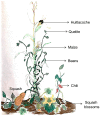Effects of Foods of Mesoamerican Origin in Adipose Tissue and Liver-Related Metabolism
- PMID: 38003956
- PMCID: PMC10672752
- DOI: 10.3390/medicina59111907
Effects of Foods of Mesoamerican Origin in Adipose Tissue and Liver-Related Metabolism
Abstract
Adipose tissue and liver metabolism play a key role in maintaining body homeostasis; therefore, their impairment conduces a pathological state. Nowadays, occidental lifestyle is a common etiological issue among a variety of chronic diseases, while diet is a unique strategy to prevent obesity and liver metabolism impairment and is a powerful player in the treatment of metabolic-related diseases. Mesoamerican foods are rich in bioactive molecules that enhance and improve adipose tissue and liver performance and represent a prophylactic and therapeutic alternative for disorders related to the loss of homeostasis in the metabolism of these two important tissues.
Keywords: Mesoamerican foods; adipose tissue; liver disease; metabolism; milpa; obesity.
Conflict of interest statement
The authors declare no conflict of interest.
Figures



Similar articles
-
Liver-adipose tissue crosstalk: A key player in the pathogenesis of glucolipid metabolic disease.Chin J Integr Med. 2017 Jun;23(6):410-414. doi: 10.1007/s11655-017-2810-4. Epub 2017 Aug 10. Chin J Integr Med. 2017. PMID: 28795382 Review.
-
The mineralocorticoid receptor: a new player controlling energy homeostasis.Horm Mol Biol Clin Investig. 2013 Sep;15(2):59-69. doi: 10.1515/hmbci-2013-0033. Horm Mol Biol Clin Investig. 2013. PMID: 25436733 Review.
-
The role of iron homeostasis in adipocyte metabolism.Food Funct. 2021 May 21;12(10):4246-4253. doi: 10.1039/d0fo03442h. Epub 2021 Apr 20. Food Funct. 2021. PMID: 33876811 Review.
-
Lipid remodeling of adipose tissue in metabolic health and disease.Exp Mol Med. 2023 Sep;55(9):1955-1973. doi: 10.1038/s12276-023-01071-4. Epub 2023 Sep 1. Exp Mol Med. 2023. PMID: 37653032 Free PMC article. Review.
-
Interaction of Adipocyte Metabolic and Immune Functions Through TBK1.Front Immunol. 2020 Oct 20;11:592949. doi: 10.3389/fimmu.2020.592949. eCollection 2020. Front Immunol. 2020. PMID: 33193441 Free PMC article. Review.
Cited by
-
Milpa Diet for MASLD in Mesoamerican Populations: Feasibility, Advantages, and Future Perspectives.Life (Basel). 2025 May 19;15(5):812. doi: 10.3390/life15050812. Life (Basel). 2025. PMID: 40430238 Free PMC article. Review.
References
-
- Liu X., Wang H., Liang X., Roberts M.S. Hepatic Metabolism in Liver Health and Disease. In: Muriel P., editor. Liver Pathophysiology. Academic Press; Cambridge, UK: 2017. pp. 391–400.
Publication types
MeSH terms
Grants and funding
LinkOut - more resources
Full Text Sources
Medical

